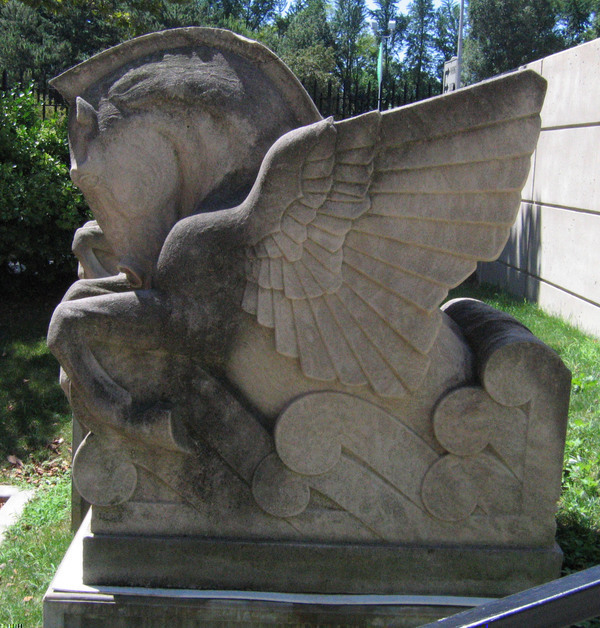Time to Clean the Pegasi!
Over a few days each summer the object conservators and the conservation summer interns get to venture out to the sculpture garden to treat the outdoor sculptures.

One Pair of Pegasi
This summer we cleaned the Four Pairs of Pegasi located along the staircase by the staff entrance. The Pegasi were originally made for the Coney Island High Pressure Pumping Station at 2301 Neptune Avenue. The horses were brought to the Museum in March of 1981 as a result of Project S.A.V.E. of the Landmarks Preservation Commission. The horses are carved from limestone of the oolitic variety as many seashells are evident within the body of the stone.
The Pegasi were placed in their current location on concrete pedestals in 2004. Regular maintenance on the Pegasi began last summer when the conservators cleaned them to remove dirt, pollutants and biological growth. Cleaning involved gently scrubbing the horses with water and a detergent. Following cleaning, a biocide was applied to further remove the existing biological growth.


Pegasus Before Treatment (left) and After Treatment (right) in 2006
It was hoped that this biocide would serve to reduce the reoccurrence of biological growth over the next few years, and so far it seemed to have worked fairly well! When examined this summer, the Pegasi appeared to have much less biological growth present. The treatment this summer was identical to last summer – cleaning with a detergent and application of a biocide. It is hoped that the Pegasi are able to be cleaned on a fairly regular basis – about every two summers.


Maintenance 2007: (Left Image) Kate Wight, a summer intern from the Winterthur / University of Delaware Program in Art Conservation, (Right Image) Emy Kim, Brooklyn’s Third Year Intern from the NYU Program in Art Conservation and Chris Watters, a summer intern from the Buffalo Program in Art Conservation
Although it is impossible to completely halt changes to sculptures which are displayed outdoors, a regular maintenance program can help to protect the works from significant deterioration caused by atmospheric pollution. Deposits of soil and pollutants from the air support the growth of fungal cells on porous stone sculpture such as limestone. Once begun, the roots of such growth penetrate the stone causing staining and if left untreated complete destruction of the stone itself. Regular maintenance to remove these harmful materials will help to preserve the works for future generations.

Jakki Godfrey is an assistant conservator of objects at the Brooklyn Museum. She received her Master's Degree in Conservation from the Winterthur / University of Delaware Program in Art Conservation. Before working at Brooklyn she interned at the Smithsonian National Museum of Natural History and the National Museum of African Art in Washington, DC, the Asian Art Museum in San Francisco and the Stedelijk Museum in Amsterdam.
